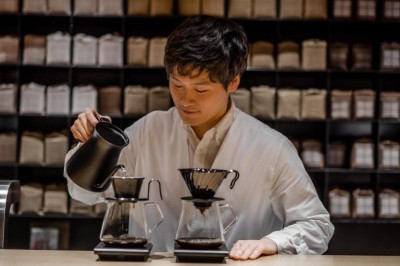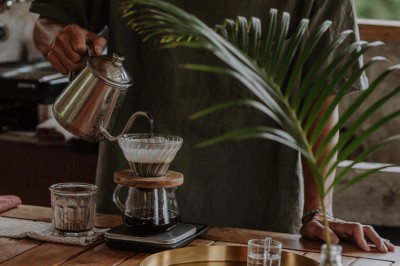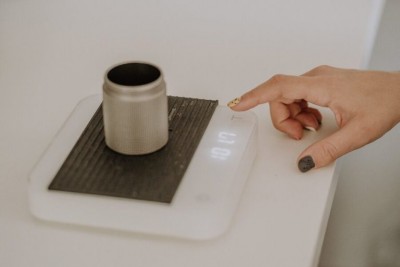With so many methods to choose from, it can be overwhelming to figure out which one suits your taste best. In this guide, and our first blog post, we’ll explore different brewing techniques and share our tips to help you get the most flavor out of your coffee beans.
1. The French Press Method
What You Need:
- French Press
- Coarsely ground coffee
- Hot water (not boiling, around 200°F or 93°C)
- Stirring spoon
Steps:
- Measure and Grind: Use a ratio of 1:15, coffee to water. For example, if you have 30 grams of coffee, you’ll need 450 ml of water. Grind your coffee beans to a coarse texture, similar to sea salt.
- Add Coffee and Water: Place the ground coffee in the French Press. Pour hot water over the grounds, ensuring all the coffee is saturated. Give it a gentle stir to mix.
- Steep: Place the lid on the French Press with the plunger pulled all the way up. Let the coffee steep for about 4 minutes.
- Press and Pour: Slowly press the plunger down to separate the grounds from the brewed coffee. Pour the coffee into your mug immediately to avoid over-extraction.
Tips:
- Experiment with steeping times to find your preferred strength.
- ONLY use freshly ground coffee!!! please
2. The Pour-Over Method
What You Need:
- Pour-over dripper (e.g., V60, Chemex)
- Medium-fine ground coffee
- Paper filter
- Hot water (about 200°F or 93°C)
- Gooseneck kettle (optional for precision)
Steps:
- Measure and Grind: Use a 1:16 coffee to water ratio. For example, 25 grams of coffee for 400 ml of water. Grind your beans to a medium-fine consistency.
- Prepare Filter: Place the paper filter in the dripper and rinse it with hot water to remove any paper taste and preheat the dripper. Discard the rinse water.
- Add Coffee: Place the ground coffee in the filter.
- Bloom: Pour a small amount of hot water (about twice the weight of the coffee) over the grounds to let them bloom for 30-45 seconds. This releases carbon dioxide and enhances flavor extraction.
- Pour: Gradually pour the remaining hot water over the coffee in a slow, circular motion, maintaining a steady stream. Aim for a total brew time of about 3-4 minutes.
Tips:
- Use a gooseneck kettle for better control over the water flow.
- Adjust grind size and pouring technique to fine-tune your brew.
3. The Espresso Method
What You Need:
- Espresso machine
- Finely ground coffee
- Tamper
Steps:
- Measure and Grind: Use a ratio of 1:2 coffee to water. For example, 18 grams of coffee for a 36-gram espresso shot. Grind your beans to a fine texture, similar to table salt.
- Prepare Portafilter: Place the ground coffee in the portafilter. Distribute it evenly and tamp firmly to create a level surface.
- Brew: Lock the portafilter into the espresso machine and start the extraction. Aim for a shot time of about 25-30 seconds.
- Enjoy: Your espresso should have a rich, creamy layer of crema on top.
Tips:
- Use freshly roasted and ground coffee for the best results.
- Experiment with grind size, dose, and extraction time to perfect your shot.
4. The Cold Brew Method
What You Need:
- Coarsely ground coffee
- Cold water
- Large jar or cold brew maker
- Fine mesh sieve or coffee filter
Steps:
- Measure and Grind: Use a 1:8 coffee to water ratio. For example, 100 grams of coffee for 800 ml of water. Grind your beans to a coarse texture.
- Mix: Combine the ground coffee and cold water in a large jar. Stir to ensure all the grounds are saturated.
- Steep: Cover and let it steep in the refrigerator for 12-24 hours, depending on your desired strength.
- Filter: Strain the coffee through a fine mesh sieve or a coffee filter to remove the grounds. Transfer the cold brew to a clean jar.
- Serve: Dilute with water or milk to taste and serve over ice.
Tips:
- Cold brew concentrate can be stored in the fridge for up to two weeks.
- Experiment with steeping times and coffee-to-water ratios for your perfect flavor.
Brewing the perfect cup of coffee is all about experimenting with different methods and finding what works best for your taste buds. Whether you prefer the bold flavours of a French Press, the delicate nuances of a pour-over, the intensity of an espresso, or the smoothness of cold brew, there’s a method for everyone. Happy brewing!



